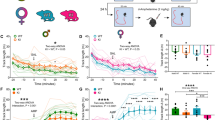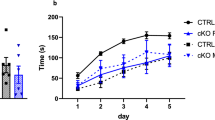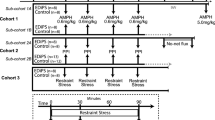Abstract
The transcription factor Nurr1 (NR4A2) has been found to play a critical role in the development of midbrain dopaminergic neurons. Nurr1 heterozygous (+/−) male and female mice expressing 35–40% of normal levels of Nurr1 were generated and examined in animal models related to symptoms of schizophrenia. The Nurr1 (+/−) mice displayed hyperactivity in a novel environment, which persisted after administration of the dopamine-mimetic amphetamine and the N-methyl-D-aspartate receptor antagonist phencyclidine. The Nurr1 (+/−) mice were deficient in the retention of emotional memory and showed an enhanced response to swim stress. In addition, Nurr1 (+/−) male mice displayed a reduced dopamine turnover in the striatum and an enhanced dopamine turnover in the prefrontal cortex, while female mice showed an opposite pattern. These results show that Nurr1 (+/−) mice display a pattern of behaviors indicative of potential relevance for symptoms of schizophrenia combined with a gender-specific abnormal dopamine transmission in the striatum and prefrontal cortex, respectively. This suggests that the Nurr1 mutant mouse may be a potential animal model for studies on some of the behavioral and molecular mechanisms underlying schizophrenia.
This is a preview of subscription content, access via your institution
Access options
Subscribe to this journal
Receive 12 print issues and online access
$259.00 per year
only $21.58 per issue
Buy this article
- Purchase on Springer Link
- Instant access to full article PDF
Prices may be subject to local taxes which are calculated during checkout





Similar content being viewed by others
References
Ban TA, Guy W, Wilson WH . Description and distribution of the subtypes of chronic schizophrenia based on Leonhard's classification. Psychiatr Dev 1984; 2: 179–199.
Carlsson A . The dopamine theory revisited. In: Hirsch SR, Weinberger DR (ed). Schizophrenia. Blackwell Science: Oxford, 1995, pp 379–400.
Creese I, Burt DR, Snyder SH . Dopamine receptor binding predicts clinical and pharmacological potencies of antischizophrenic drugs. Science 1976; 192: 481–483.
Seeman P, Lee T, Chau-Wong M, Wong K . Antipsychotic drug doses and neuroleptic/dopamine receptors. Nature 1976; 261: 717–719.
Griffith JD, Cavanaugh J, Held J, Oates JA . Dextroamphetamine: evaluation of psychotomimetic properties in man. Arch Gen Psychiatry 1972; 26: 97–100.
Gerfen CR . The neostriatal mosaic: multiple levels of compartmental organization in the basal ganglia. Annu Rev Neurosci 1992; 15: 285–320.
LeMoal M, Simon H . Mesocorticolimbic dopaminergic network: functional and regulatory roles. Physiol Rev 1991; 71: 155–234.
Leung HC, Seelig D, Gore JC . The effect of memory load on cortical activity in the spatial working memory circuit. Cogn Affect Behav Neurosci 2004; 4: 553–563.
Konradi C, Heckers S . Molecular aspects of glutamate dysregulation: implications for schizophrenia and its treatment. Pharmacol Ther 2003; 17: 153–179.
Carlsson A, Waters N, Holm-Waters S, Tedroff J, Nilsson M, Carlsson ML . Interactions between monoamines, glutamate, and GABA in schizophrenia: new evidence. Annu Rev Pharmacol Toxicol 2001; 41: 237–260.
Krystal JH, Anand A, Moghaddam B . Effects of NMDA receptor antagonists: implications for the pathophysiology of schizophrenia. Arch Gen Psychiatry 2002; 59: 663–664.
Javitt DC, Zukin SR . Recent advances in the phencyclidine model of schizophrenia. Am J Psychiatry 1991; 148: 1301–1308.
Morris BJ, Cochran SM, Pratt JA . PCP: from pharmacology to modelling schizophrenia. Curr Opin Pharmacol 2005; 5: 101–106.
Ögren SO . The behavioral pharmacology of typical and atypical antipsychotic drugs. In: Csernansky JG (ed). The Handbook of Experimental Pharmacology: Antipsychotics, vol. 120. Springer Verlag: Heidelberg, 1996, pp 225–244.
Weinberger DR, Manreco S . Schizophrenia as a neurodevelopmental disorder. In: Hirsch SR, Weinberger DR (eds). Schizophrenia. Blackwell: Oxford, 2003, pp 326–348.
Zetterström RH, Solomin L, Jansson L, Hoffer BJ, Olson L, Perlmann T . Dopamine neurons agenesis in Nurr1-deficient mice. Science 1997; 276: 248–250.
Castillo SO, Baffi JS, Oalkovits M, Goldstein DS, Kopin IJ, Witta J et al. Dopamine biosynthesis is selectively abolished in substantia nigra/ventral tegmental area but not in hypothalamic neurons in mice with targeted disruption of the Nurr1 gene. Mol Cell Neurosci 1998; 11: 36–46.
Saucedo-Cárdenas O, Quintana-Hau JD, Le WD, Smidt MP, Cox JJ, De Mayo F et al. Nurr1 is essential for the induction of the dopaminergic phenotype and the survival of ventral mesencephalic late dopaminergic precursor neurons. Proc Natl Acad Sci USA 1998; 95: 4013–4018.
Sakurada K, Ohshima-Sakurada M, Palmer TD, Gage FH . Nurr1, an orphan nuclear receptor, is a transcriptional activator of endogenous tyrosine hydroxylase in neural progenitor cells derived from the adult brain. Development 1999; 126: 4017–4026.
Sacchetti P, Mitchell TR, Granneman JG, Bannon MJ . Nurr1 enhances transcription of the human dopamine transporter gene through a novel mechanism. J Neurochem 2001; 76: 1565–1572.
Bäckman C, Perlmann T, Wallen A, Hoffer RJ, Morales M . A selective group of dopaminergic neurons express Nurr1 in the adult mouse brain. Brain Res 1999; 851: 125–137.
Buervenich S, Carmine A, Arvidsson M, Xiang F, Zhang Z, Sydow O et al. Nurr1 mutations in cases of schizophrenia and manic-depressive disorder. Am J Med Genet (Neuropsychiatric Genet) 2000; 96: 808–813.
Xing G, Zhang L, Russell S, Post R . Reduction of dopamine-related transcription factors Nurr1 and NGFI-B in the prefrontal cortex in schizophrenia and bipolar disorders. Schizophr Res 2006; 84: 36–56.
Eells JB, Lipska BK, Yeung SK, Misler JA, Nikodem VM . Nurr1-null heterozygous mice have reduced mesolimbic and mesocortical dopamine levels and increased stress-induced locomotor activity. Behav Brain Res 2002; 136: 267–275.
Ögren SO, Hall H, Kohler C, Magnusson O, Sjostrand SE . The selective dopamine D2 receptor antagonist raclopride discriminates between dopamine-mediated motor functions. Psychopharmacology (Berl) 1986; 90: 287–294.
Misane I, Ögren SO . Multiple 5-HT receptors in passive avoidance: comparative studies of p-chloroamphetamine and 8-OH-DPAT. Neuropsychopharmacology 2000; 22: 168–190.
Kuteeva E, Hökfelt T, Ögren SO . Behavioural characterisation of young adult transgenic mice overexpressing galanin under the PDGF-B promoter. Regul Pept 2005; 125: 67–78.
Larsson L-G, Rényi L, Ross SB, Svensson B, Ängeby-Möller K . Different effects on the responses of functional pre- and postsynaptic 5-HT1A receptors by repeated treatment of rats with the 5-HT1A receptor agonist 8-OH-DPAT. Neuropharmacology 1990; 29: 85–91.
Richelson E . Receptor pharmacology of neuroleptics: relation to clinical effects. J Clin Psychiatry 1999; 60 (Suppl 10): 5–14.
Gainetdinov RR, Mohn AR, Caron MG . Genetic animal models: focus on schizophrenia. Trends Neurosci 2001; 24: 527–533.
Giros B, Javer M, Jones SR, Wightmann RM, Caron MG . Hyperlocomotion and indifference to cocaine and amphetamine in mice lacking the dopamine transporter. Nature 1996; 379: 606–612.
Schotte A, Janssen PF, Megens AA, Leysen JE . Occupancy of central neurotransmitter receptors by risperidone, clozapine and haloperidol, measured ex vivo by quantitative autoradiography. Brain Res 1993; 631: 191–202.
Mohn AR, Gainetdinov RR, Caron MG, Koller BH . Mice with reduced NMDA receptor expression display behaviors related to schizophrenia. Cell 1999; 98: 427–436.
Hafner H . Gender differences in schizophrenia. Psychoneuroendocrinology 2003; 2: 17–54.
Ivanova T, Beyer C . Estrogen regulates tyrosine hydroxylase expression in the neonate mouse midbrain. J Neurobiol 2003; 54: 638–647.
Lahti RA, Roberts RC, Conley RR, Cochrane EV, Mutin A, Tamminga CA . D2-type dopamine receptors in postmortem human brain sections from normal and schizophrenic subjects. Neuroreport 1996; 7: 1945–1948.
Lindstrom LH, Gefvert O, Hagberg G, Lundberg T, Bergstrom M, Hartvig P et al. Increased dopamine synthesis rate in medial prefrontal cortex and striatum in schizophrenia indicated by L-(beta-11C) DOPA and PET. Biol Psychiatry 1999; 46: 681–688.
Goldman-Rakic PS, Castner SA, Svensson TH, Siever LJ, Williams GV . Targeting the dopamine D1 receptor in schizophrenia: insights for cognitive dysfunction. Psychopharmacology (Berl) 2004; 174: 3–16.
Exner C, Boucsein K, Degner D, Irle E, Weniger G . Impaired emotional learning and reduced amygdala size in schizophrenia: a 3-month follow-up. Schizophr Res 2004; 71: 493–503.
Silver H, Shlomo N . Perception of facial emotions in chronic schizophrenia does not correlate with negative symptoms but correlates with cognitive and motor dysfunction. Schizophr Res 2001; 52: 265–273.
Phillips R, LeDoux JE . Differential contribution of amygdala and hippocampus to cued and contextual fear conditioning. Behav Neurosci 1992; 106: 274–285.
Stiedl O, Misane I, Spiess J, Ogren SO . Involvement of the 5-HT1A receptors in classical fear conditioning in C57BL/6J mice. J Neurosci 2000; 20: 8515–8527.
Juckel G, Gallinat J, Riedel M, Sokullu S, Schulz C, Moller HJ et al. Serotonergic dysfunction in schizophrenia assessed by the loudness dependence measure of primary auditory cortex evoked activity. Schizophr Res 2003; 64: 115–124.
Luttgen M, Elvander E, Madjid N, Ögren SO . Analysis of the role of 5-HT1A receptors in spatial and aversive learning in the rat. Neuropharmacology 2005; 48: 830–852.
Nicholson IR, Neufeld RW . A dynamic vulnerability perspective on stress and schizophrenia. Am J Orthopsychiatry 1992; 62: 117–130.
Crispino M, Tocco G, Feldman JD, Herscham HR, Baudry M . Nurr1 mRNA expression in neonatal and adult rat brain following kainic acid-induced seizure activity. Brain Res Mol Brain Res 1998; 59: 178–188.
Acknowledgements
We thank Norma Serrano and Nather Majid for technical assistance. This study was partially supported by Göran Gustafsson Foundation, Research funds of Karolinska Institute, Swedish Foundation for Strategic Research, The Swedish Research Council and Wallenberg Consortium North.
Author information
Authors and Affiliations
Corresponding author
Rights and permissions
About this article
Cite this article
Rojas, P., Joodmardi, E., Hong, Y. et al. Adult mice with reduced Nurr1 expression: an animal model for schizophrenia. Mol Psychiatry 12, 756–766 (2007). https://doi.org/10.1038/sj.mp.4001993
Received:
Revised:
Accepted:
Published:
Issue Date:
DOI: https://doi.org/10.1038/sj.mp.4001993
Keywords
This article is cited by
-
Glucose may Contribute to Retrieval and Reconsolidation of Contextual Fear Memory Through Hippocampal Nr4a3 and Bdnf mRNA Expression and May Act Synergically with Adrenaline
Molecular Neurobiology (2024)
-
Prolonged cardiac NR4A2 activation causes dilated cardiomyopathy in mice
Basic Research in Cardiology (2022)
-
Working memory deficits in schizophrenia are associated with the rs34884856 variant and expression levels of the NR4A2 gene in a sample Mexican population: a case control study
BMC Psychiatry (2021)
-
NEIL1 and NEIL2 DNA glycosylases modulate anxiety and learning in a cooperative manner in mice
Communications Biology (2021)
-
NURR1 deficiency is associated to ADHD-like phenotypes in mice
Translational Psychiatry (2019)



